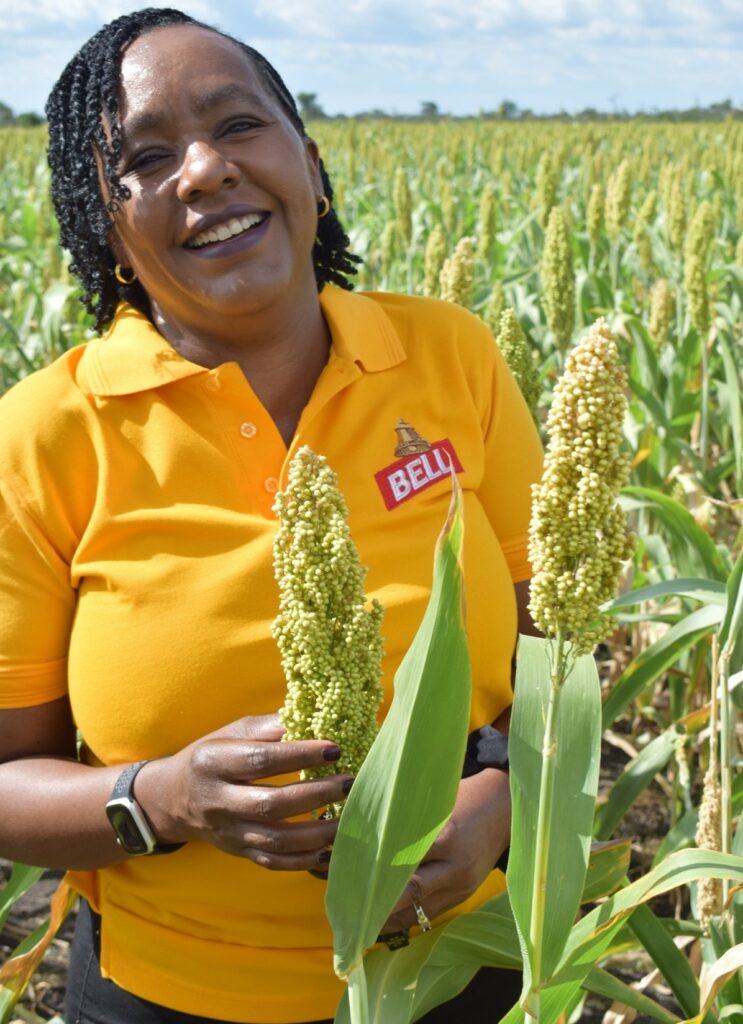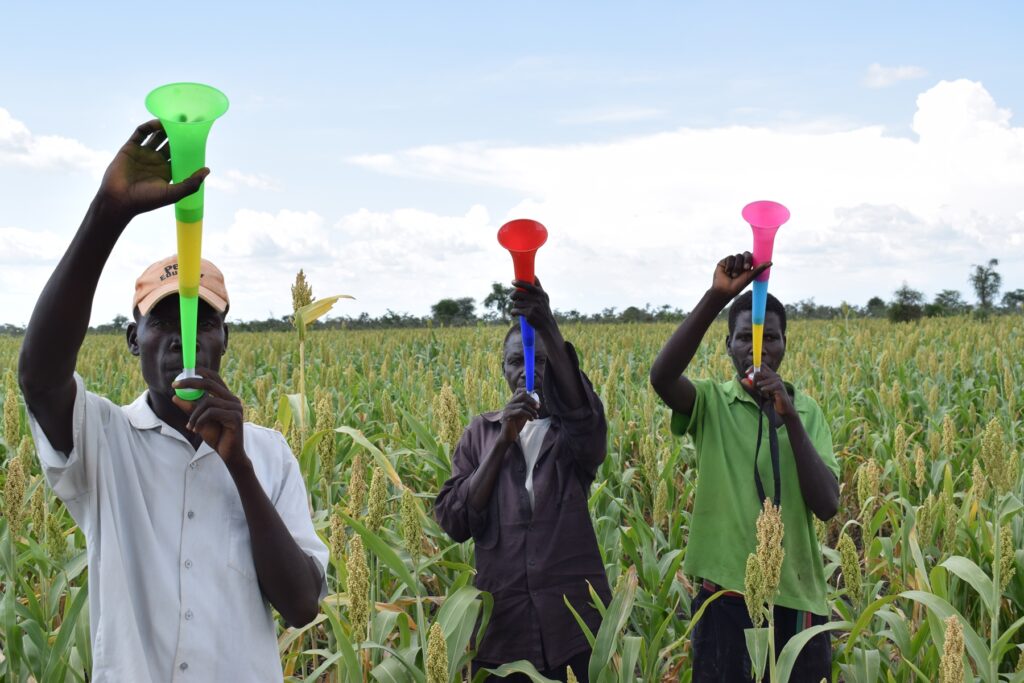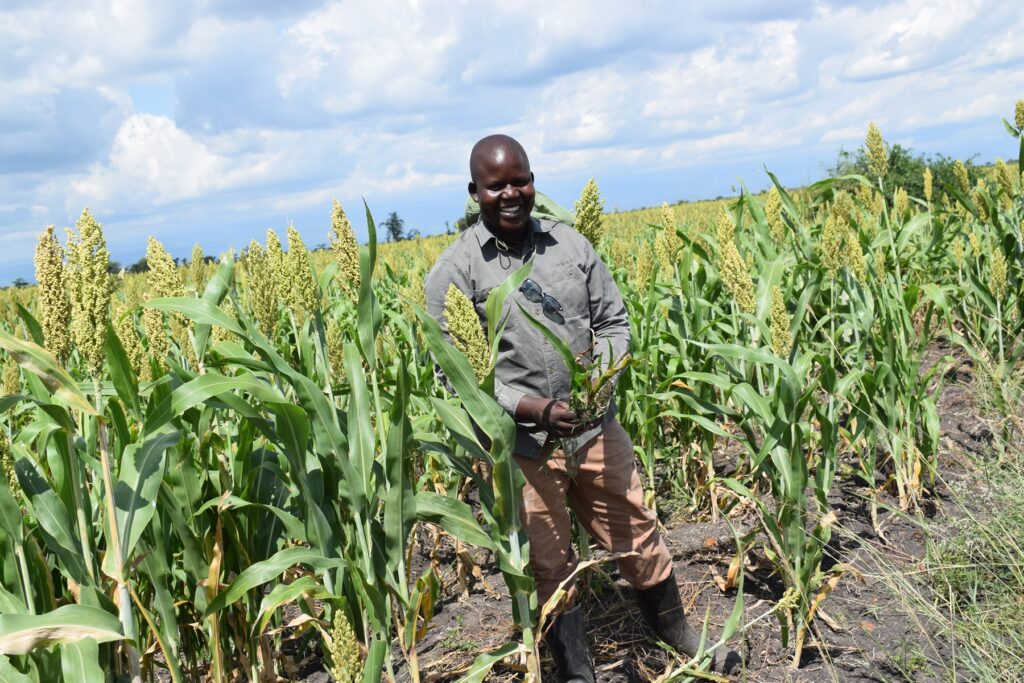By Moses Nampala
Somewhere among farming fields, Tibile village, in Kangole sub-county in Bukedea district, lies an expansive field of sorghum.
The extensive field of grain cereal crop is breathtaking as it stretches out, far as the eye can see.
As wind blows, a maze of now tall, healthily fruited stalks of sorghum, bow in along giant wave, before recovering their upright position. A sudden burst of a vuvuzela rents the air, compelling the birds that had descended on the sorghum field to scamper, chipping, as they fly away in fright.
A vuvuzela is along horn instrument usually blown by soccer fans.
“The greatest challenge a farmer engaged in sorghum grain cereal crop has to brace for, are the birds,” observes Solomon Moses Odong one of hundreds of farmers growing the grain cereal crop on a commercial scale.
The birds are no longer frightened by traditional scarecrows. And farmers keep innovating on how to scare off the birds.
“Today a farmer worth their salt has to commit a budget to pay vuvuzela blowers, if he /she won’t lose the entire field of sorghum to birds,” observes Odong with a chuckle.

At 32 years old, Odong is one of the formidable farmers growing sorghum on an extensive scale.
His sorghum field sits on 15 acres and the crop is ready for harvest.
“I anticipate to reap about 12 tonnes, almost two-fold more than the last harvest. For this time around, the kind almighty God, has graced with good weather, that was punctuated with, among others timely rain, all through,” says Odong. He is among the thousands of farmers growing sorghum and supplying it to Uganda Breweries Ltd.
Time immemorial, sorghum, like millet, is part of household staple food among the natives of Teso sub-region, in north –eastern Uganda.
The crop is usually grown with millet, though in modest quantity.
Like millet, in the past, upon harvest, households would store it in granaries as a prudent food security measure.
However introduction of sorghum beer on market, about 10 years ago, but most importantly when the largely imported traditional beer raw material, (wheat and barley) cereal crops among others, became so expensive, local brewing giants have since started to gradually shift away from it,
switching to making beer out of sorghum, which is grown locally.
Introduction of sorghum beer provided an opportunity to improve production of the crop as well as improving welfare of farmers growing it countrywide. Odong is one of the farmers who grabbed this opportunity.

SORGHUM VARIETY
Odong says there are many varieties of sorghum. However, Odong uses NARO SORG 1, sorghum variety. This is one of the latest varieties produced by the National Agriculture Research Organisation (NARO). According to Odong, a kilo of seed material goes for sh5,000. Each acre requires 4kg of sorghum seed.
FIELD PREPARATION
Odong carries out two separate ploughing exercises before planting the seed. Ploughing an acre using the local tractor services goes for sh100,000.
Odong observes that from the inception they been implored to use the lining modality, observing a 60 cm between to line and 30 plant to plant. “A farmer is required to drop five seeds in each hole, in case some seeds do not germinate. However, when the crop has germinated and is 2 weeks old, he/she is obliged to uproot the 3 extra stalks, leaving only two,” explains Odong.
WEEDING
First weeding is usually carried out when the crop has attained three weeks old. Odong says locally sourced labourers charge sh50,000 weeding an acre garden / field. The second weeding is usually done when the crop is six weeks old. NARO SORG 1 sorghum variety is a resilient variety and quick maturing.
PESTS /DISEASES
He says the most common fungal disease includes a stem-borer, shoot fly, sorghum mite, sorghum smat and leaf blight.
“Often fungal diseases have responded well when fungicides are applied,” he says.
On the other hand, odong has had to use a multi-dimensional measure to handle cases of sorghum smat and leaf blight.
“The two are so contagious as they spread very fast. I’ve always been compelled to uproot the affected plants and burn them about 100 metres away from the field,” says Odong.
Alongside uprooting, he also has time to spread fungicides to crops that have not yet been affected. The trick has always yielded positive results, he observes.
MATURITY
The cereal crop matures after 100 days (about three and half months) Invention of crop motorized threshers has quickened the chore of harvesting as it includes tarpaulins and hiring about 10 labourers.
When the sorghum bulbs are harvested, they are fed in the thresher device that separates chuff from the grains.
“The contract farming firm has eased things for a farmer. By the time a farmer is harvesting trucks are at hand to help transport the grains. When processed sorghum grains are packed in sacks, the bulk is weighed and loaded on trucks.
“A critical occupation a farmer has to do at this time, is merely taking down kg of each sack, then later compute the net weight of the harvest by the farm gate price of sh1,100 and the next thing would be getting paid,” he observes smiling.
Farm plans
Odong`s target is to produce at least 50acres of sorghum in three years. “I will not turn back. I am aiming at increasing my acreage to about 50 acres by ploughing back whatever profits that I make,” he says. He already has land to carry out the expansion.
ACHIEVEMENTS
It is a positive stride in the right direction for Odong. “Out of the sorghum enterprise I have acquired several pieces of land
of which I have since developed with commercial structures,” he observes.
At 32 years old, Odong is not only role model youth, but has won endearment from circles of financially sound community class. The enterprise has enabled him to periodically employ a dozen people.
He is always using his social standing to encourage scores of youth into meaningful economic activities of farming.
“I feel proud to announce that about 200 youth have heeded my word and are engaged in invariable farming activities,” he observes.
CHALLENGES
Last year he almost bowed out of business. “I lost 10 acres of sorghum to the dreadful army worm pests,” he observes.
The pests struck his sorghum field when it was only three weeks old.
“I had incur extra expenses in acquiring fresh seed, labour expenses not withstanding to ensure that the season doesn’t come to an end when he has nothing to sale at the end of the day, lately with the help of pesticides I realised a humble harvest at the end of the day,” he says reflectively.
Odong says that the most critical challenge youth have suffered nationwide has been access to credit.
“My earnest appeal to relevant authorities in government is to strive and come to the rescue of the youth. There are scores of youth that desperately want to start up economic activities but get handicapped as credit institution demand collateral that they don’t have,” he observes.

BACKGROUND
Born to Julius Odong and Elizabeth Muchele, of Mukura, Mukura, in Ngora district, he is the last born of the 12 children the couple bore.
He went to Madoch Ailack P/s in Mukura and later join Mukura Memorial secondary school for both O &A level. He holds a diploma in Business administration from Cavendish University.
Turning what he is today has exclusively been a result of his character, good will and kindness of a few financially sound
personalities around.
“I come from a very humble back ground but with an apparent trait of hard work. Right through my adolescent I’ve been doing every odd job among others weeding and ploughing for people in exchange for some little money,” he observes.
Yet the attribute of hard work, coupled with honesty would endear him people of high social standing in his community.
Overtime financially sound peasant around the village would take him in, beginning with working him in produce business.
His social standing slowly but steadily, would evolve, as his employer (produce dealers) started to send him on business errands to buy grains on their behalf, a chore he would perfectly do well.
When Uganda breweries started enlisting farmers that would supply them with sorghum, Odong went for it.
“In 2017 when I became Uganda breweries aggregator I opted to convince my former employer (produce dealers) to lend me money, that I could use in hiring land where I would grow sorghum. I’m grateful to them, that at the time they Obliged,” he reflectively recalls.
He would pay his creditors (former employer) when he sold off his maiden produce from his pioneer five-acre sorghum garden. “The little profit margin in the venture would help me to kickstart my life and I have never looked back,: he observes, for a moment staring in space. He is married to Asiyo Debora.
WHAT PEOPLE SAY
Eunice Waweru, finance and strategic director, Uganda Breweries
limited,
Odong as a role model youth. Our dream is to have more rural youth that constitute majority of population not only participate in the growing sorghum but turn around their lives for the better.
Charles Okubal, Director Landmark dealers
Odong is among the very few youth that has defied odds. He is a young man who oozes a sense of maturity. He is honest, organised, hardworking, innovative and ever progressive.
Ruth Ikiring, who manages Odong’s sorghum fields
He pays our wages on time and will stand with his subject, in times of grief.
Uses of sorghum in Uganda-tips by NAADS
• In Uganda, like in many countries in sub-Saharan Africa most of the sorghum produced
(47%) is consumed at household level followed by selling grain.
• Sorghum being an important food security crop, a greater percentage is stored mostly for
later use as food.
• Much of what is sold is used for making alcohol lager beer by East African Breweries
and Nile Breweries.
• The grain is sometimes an ingredient of livestock feed while the stover is used for forage.
• The forage may be fed sole or mixed with brewer’s mash.
• The mash is also a good laxative feed for lactating cattle which results in increased milk
production.
Sorghum farmers’ desirable attributes
• Despite the availability of high yielding improved sorghum varieties, more than 60% of
sorghum farmers in Uganda grow land races much as they are low yielding.
• However, through participatory interaction with farmers desirable attributes were
identified.
• This has led to developing sorghum genotypes with the attributes desired on the market in
order to increase adoption rates.
• The market driven attributes include; tolerance to prevalent constraints especially striga,
drought, disease and insect pests, low soil fertility.
• Like in most East African countries farmers in Uganda prefer brown to red grain sorghum
because of the minimal damage from birds.
• The sorghum with brown and red color is associated with high tannin levels and less
preferred by birds.
• In addition specialty sorghum such as SESO1 was developed for breweries for making
lager beer brands such as eagle, senator, engule and chibuku.
• The panicles should be compact with bold grains.
• Other attributes preferred by farmers include; short glumes, palatability, easy to grind, resistance to lodging, stay green and sweet stems.
Ecological requirements for sorghum production
• Sorghum is adapted to a wide range of ecological conditions, surviving in the tropical,
sub-tropical and temperate regions of the world.
• It is planted in areas considered to be too dry and hot for other cereals to survive because
of its tolerance to drought and heat stress.
• The adaptability enables sorghum to grow from sea level to above 2000m above sea
level.
• However, sorghum performs well under optimum conditions of deep well-drained fertile
soils, moderate to high relatively stable rainfall distribution most of which should be
received during the vegetative phase and temperate to warm weather (20-30°C).
• These conditions result in a yield potential of 3000-5000Kgha-1 if improved cultivars are
used.
• Unfortunately, the high yield potential is not realized in Uganda because farmers grow
low yield potential sorghum under low-input semi-arid conditions





